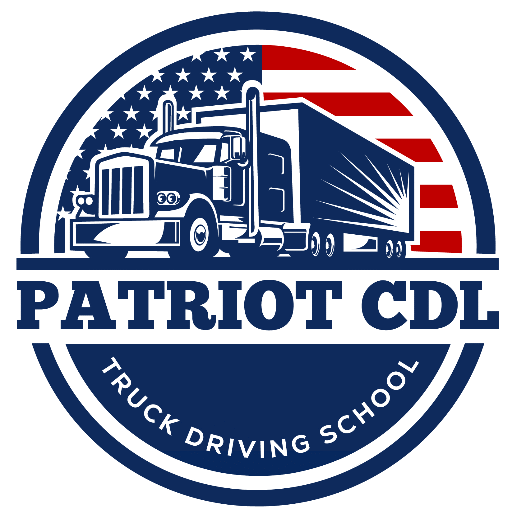So, you're thinking about getting your Commercial Driver's License. One of the first questions on everyone's mind is, "How long is this going to take?"
On average, you can expect a full-time Class A CDL training program to take somewhere between four and eight weeks. That’s a pretty solid timeframe to get you comfortable with both the classroom knowledge and the real-world, hands-on driving skills you’ll need to start a career on the road.
Your CDL Training Timeline At A Glance
Exactly how long is CDL training? The honest answer is: it depends. The biggest factors are the type of license you're going for and the intensity of the program you choose. Think of it like learning any other hands-on skill. You can take a more measured, steady approach, or you can dive in headfirst with an intensive course. Each route has its own timeline.
In the U.S., most Class A CDL programs—the ones for driving big rigs—run from 4 to 8 weeks. This schedule is designed to give you enough time to really absorb the theory and then put it into practice behind the wheel. Programs for a Class B license, which covers vehicles like dump trucks and buses, are usually shorter, often wrapping up in 2 to 6 weeks since the equipment is less complex.
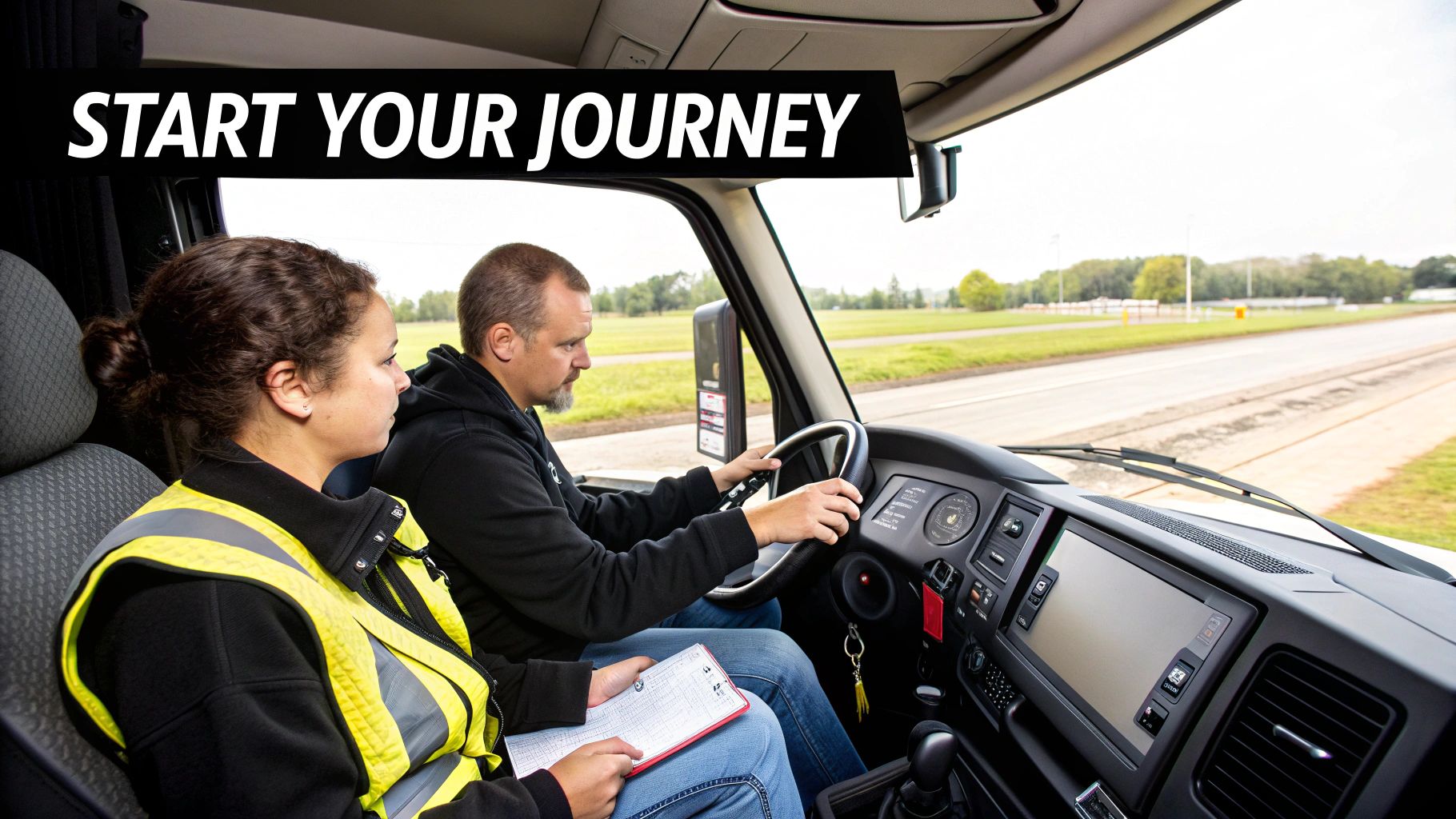
Comparing Program Timelines
To really get a feel for the options, it helps to see the typical timelines laid out. The single biggest factor that will shape your training schedule is the license class itself, as each one demands a different depth of knowledge and skill.
Naturally, a Class A license—your ticket to driving tractor-trailers—is the most involved and requires the longest training. A Class B license is a bit more straightforward, so the training is shorter. This is a crucial distinction to make when you're mapping out your career path.
The commitment for a Class A license is greater, but it also opens the door to the widest range of trucking jobs and higher earning potential right from the start.
To help you visualize the differences, here’s a quick breakdown of what you can generally expect.
Typical CDL Training Program Durations
This table gives a clear picture of how your choice of license and training format directly impacts the time you'll spend in school before you can get out on the open road.
| Program Type | Typical Full-Time Duration | Common Focus |
|---|---|---|
| Class A CDL | 4 to 8 Weeks | Tractor-trailers, long-haul freight, and combination vehicles. |
| Class B CDL | 2 to 6 Weeks | Dump trucks, school buses, and other single-chassis heavy vehicles. |
| Accelerated Program | 3 to 4 Weeks | An intensive, condensed curriculum for the fastest path to licensure. |
| Part-Time Program | 10 to 16+ Weeks | Evening or weekend classes designed for students with existing jobs. |
As you can see, there's a path for just about every schedule and career goal. Whether you want to get licensed as quickly as possible or need to fit school around your current job, there’s an option that can work for you.
What To Expect From The CDL Curriculum
So, what exactly are you doing during all those weeks of training? A solid CDL program is really a tale of two parts: time spent in the classroom and time spent on the road. This combination is crucial because it ensures you understand the rules of trucking before you ever turn the key, giving you a strong foundation that will stick with you for your entire career.
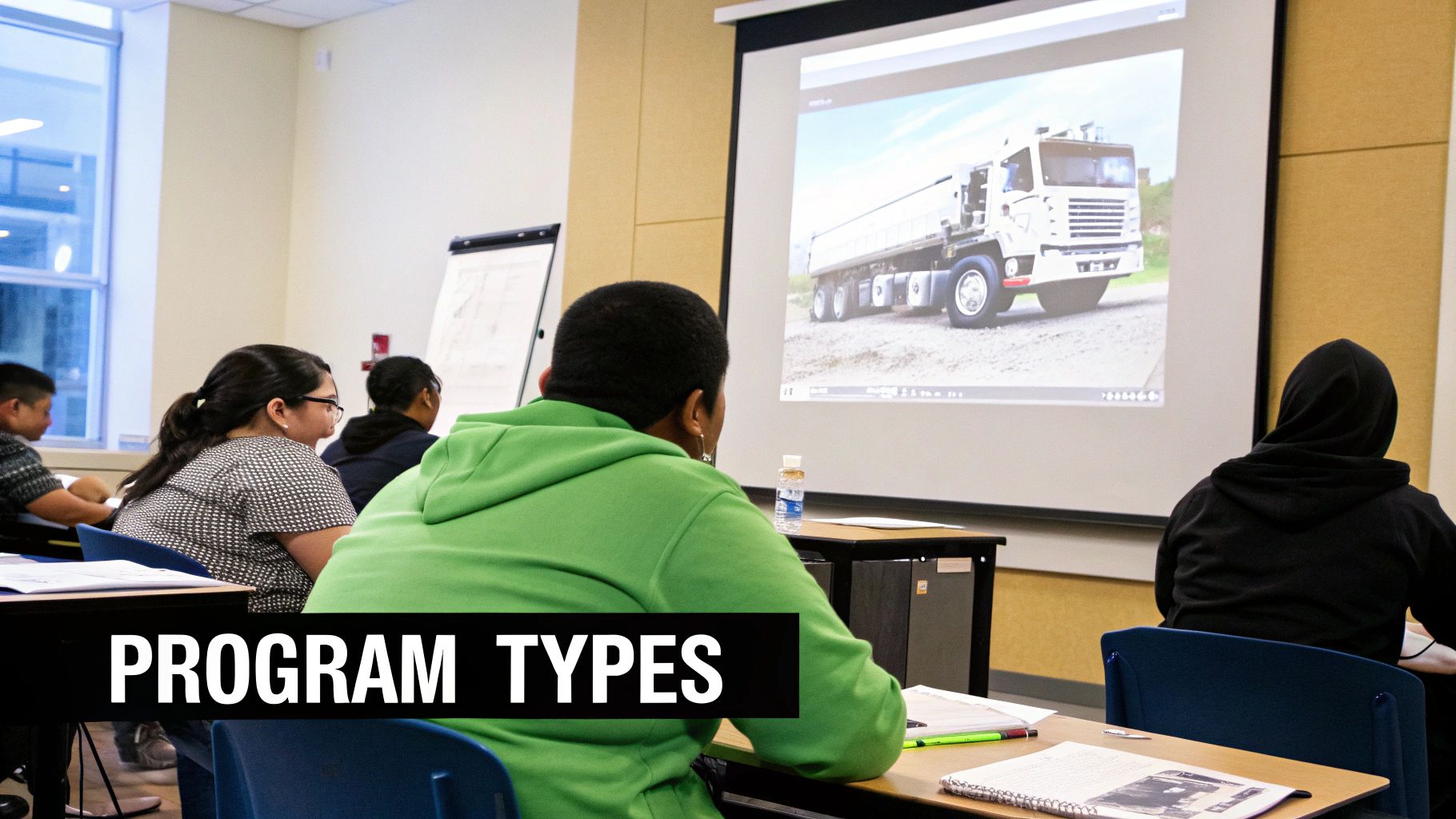
Your journey always kicks off with the essential theory. Think of it like learning the playbook before the big game—you have to know the rules, strategies, and safety protocols inside and out. This first phase is all about setting you up for success and it's a non-negotiable step before you even think about practical driving. Much of what you learn here is exactly what you’ll need to pass your initial permit exam.
Mastering The Rules Of The Road
The classroom portion is way more than just a series of lectures. It's where you'll get your hands dirty with the federal regulations that are the backbone of the entire trucking industry. You'll get up to speed on the critical details that ensure every trip you take is safe and compliant.
You can expect to cover topics like:
- Federal Motor Carrier Safety Regulations (FMCSR): These are the absolute, non-negotiable rules of the road for any professional driver.
- Pre-Trip Inspection Procedures: Learning how to walk around your rig and systematically check for safety issues is a daily ritual you’ll master. It's one of the most important things you'll do.
- Logbook Management: You’ll learn exactly how to document your Hours of Service (HOS) to stay compliant and avoid violations.
- Hazardous Materials (Hazmat) Rules: Even if you don't plan on hauling hazmat, a good program will cover the basics as part of a well-rounded safety education.
This knowledge is the bedrock of your career, and getting it down cold is your first major milestone. Once you're feeling good about this material, you'll be ready for the next big step. Our team can help you get ready for the exam, and you can learn more about how to get your permit and start your journey.
From The Classroom To The Cab
After you’ve built up that theoretical knowledge, the training pivots to where the real fun begins: getting behind the wheel. A typical full-time CDL program dedicates the majority of its time to this hands-on practice. You'll likely spend about 40 hours in the classroom and the remaining 120 hours on the driving range and out on public roads.
This behind-the-wheel phase is usually split into two distinct environments, designed to build your skills one step at a time.
A great CDL program doesn’t just teach you to pass the test; it teaches you how to be a safe, confident, and professional driver from day one. The curriculum is designed to make fundamental skills second nature.
First, you'll start on a controlled driving range. This is a safe, closed-off course where you can practice all the essential maneuvers without the stress of dealing with other cars. It's the perfect place to master skills like:
- Straight-line backing
- Alley docking
- Offset backing
- Parallel parking
Once your instructor sees that you’ve built confidence on the range, you’ll graduate to driving on public roads under their close supervision. This is where you put it all together in real-world situations, navigating city streets, highways, and tricky traffic. This is the experience that truly prepares you for the CDL exam and, more importantly, for your first job as a professional driver.
Key Factors That Influence Your Training Timeline
That "four to eight weeks" figure you hear about is a solid ballpark, but it's definitely not set in stone. Think of it like a road trip—your arrival time depends on the route you pick, how fast you're driving, and the conditions you hit along the way. Several key factors can either put you in the fast lane or lengthen the journey to getting your CDL.
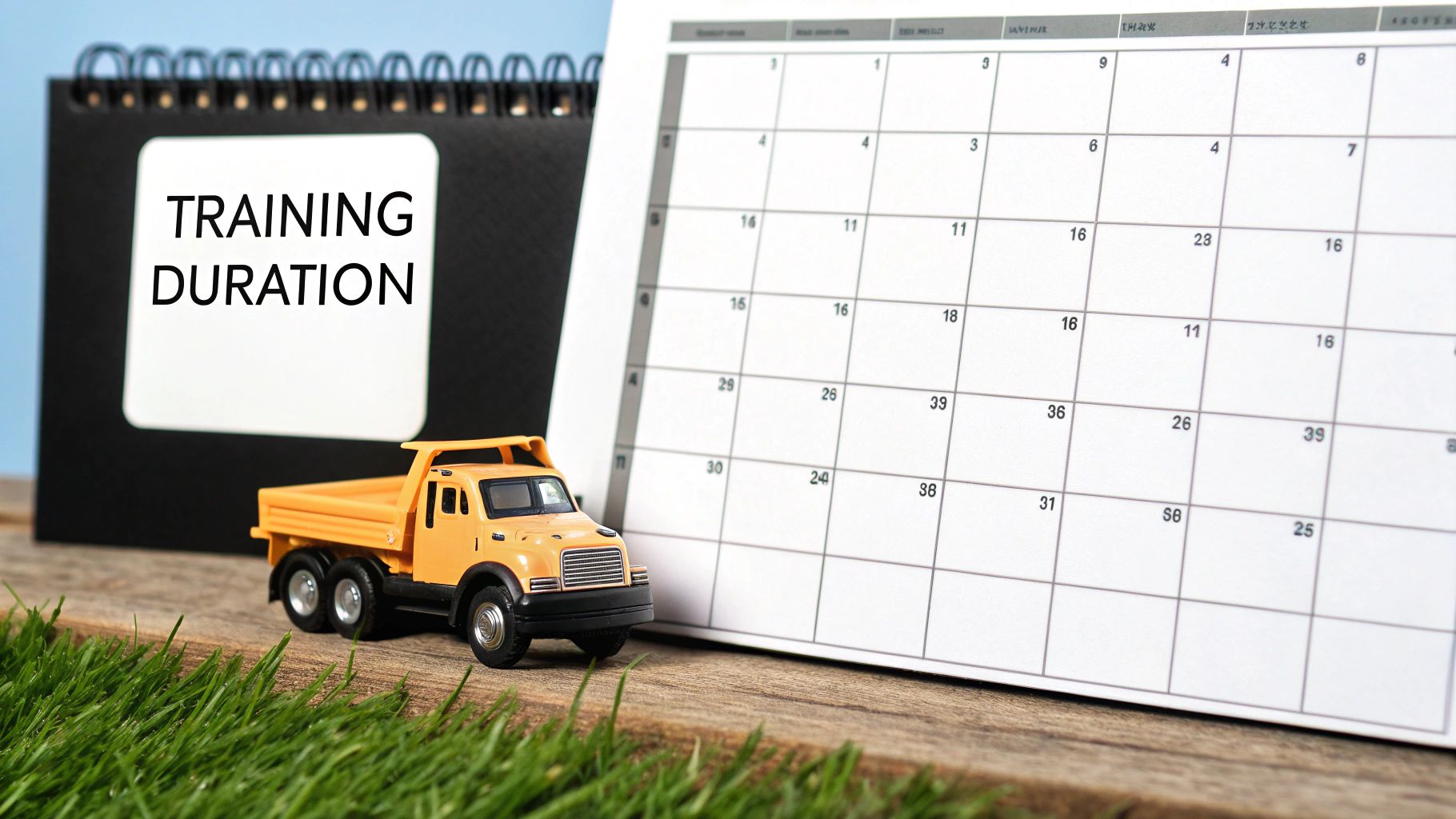
The single biggest influence on your timeline is how the program itself is built. Schools design their schedules to work for different kinds of people, whether you can go all-in full-time or need to juggle training with your current job.
Full-Time vs. Part-Time Programs
How much time you can dedicate each week is going to be a huge factor. The choice between a full-time or part-time schedule will completely change your training experience.
- Full-Time Programs: These are the express route. You’re typically in class and behind the wheel all day, Monday through Friday, clocking in about eight hours a day. This immersive approach gets you done in just a few weeks. It's the perfect path if your main goal is to get licensed and start earning as fast as possible.
- Part-Time Programs: Need to keep your current job while you learn? Part-time options are your ticket. Classes are usually scheduled for evenings or weekends, giving you the flexibility you need. You'll get the exact same number of training hours, but spreading them out means the total time to graduation can stretch out over a few months.
It all boils down to a classic trade-off: speed versus convenience.
The right program isn't just about the curriculum—it's about finding a schedule that fits your life without adding unnecessary stress. Your personal timeline is just as important as the school's.
Accelerated Courses and Your Personal Learning Pace
Some schools really put the pedal to the metal with accelerated programs. They condense the entire curriculum into an even shorter, high-intensity schedule. With these, you could be ready for your CDL exam in as little as three to four weeks. Just know that this pace demands your full focus and commitment.
On top of that, everyone learns differently. Some folks just naturally get the hang of backing maneuvers right away, while others might need a bit more time and practice to feel comfortable. A great school offers one-on-one instruction to make sure every student gets the skills down, but your own aptitude will play a role in how quickly you feel ready for the test.
Finally, state-specific rules can add time to the process, so understanding your local CDL requirements is a critical first step. Choosing a program that clicks with your learning style, schedule, and budget will set you up for the most efficient and successful training experience possible.
How Class A And Class B Timelines Differ
Not all CDL training follows the same script. The biggest factor determining how long you'll be in school is the license class you're going for: Class A or Class B.
Think of it this way: getting a Class B license is like earning a specialized certificate—it’s focused and direct. A Class A license, on the other hand, is more like a full degree program. It’s a much more comprehensive and demanding process, but it opens up a far wider range of career opportunities.
This difference in scope is why a Class A program simply takes more time. You're learning to handle the biggest, most complex rigs on the road: the classic tractor-trailers.
Why Class A Training Takes Longer
A Class A license is the top tier in the trucking world, and getting there requires a much deeper dive into advanced skills. The curriculum has to be more robust because a massive combination vehicle handles completely differently than a single-chassis truck.
You’ll spend a ton of extra time behind the wheel mastering things like:
- Coupling and Uncoupling: Learning the precise, safety-critical process of hooking a tractor to a trailer and disconnecting it properly.
- Advanced Backing: Practicing the tricky jackknife and alley dock maneuvers that are unique to articulated vehicles.
- Wide Turns & Off-Tracking: Getting a real feel for how much extra space your trailer needs to clear corners without hitting curbs or other vehicles.
Because of all this added complexity, you can expect a full-time Class A program to run anywhere from four to eight weeks. The goal is to make sure you’re not just ready for the test, but truly safe and confident on the highway.
That longer time investment for a Class A license pays off. It qualifies you to drive nearly any commercial vehicle, which means more job opportunities and significantly higher earning potential.
The Faster Path With Class B
By comparison, Class B training is much more straightforward. These programs are all about single vehicles that don't have a detachable trailer, like dump trucks, school buses, or delivery box trucks.
Since you don't have to learn the tricky dynamics of managing a 53-foot trailer, the training can be completed much faster. Most students can get through a Class B program in just two to six weeks.
You'll still cover all the essential safety rules and vehicle handling, but the curriculum is less complex. This includes mastering the crucial steps of a proper vehicle check, and you can get a head start by learning the fundamentals of a pre-trip inspection. While Class B is a quicker way to get your CDL, just remember it prepares you for a more specific range of driving jobs than the versatile Class A.
A Sample Week In CDL Training School
It's one thing to talk about hours and weeks, but what does CDL training actually look like day-to-day? Seeing a sample schedule can give you a real feel for the commitment involved and how schools expertly balance classroom theory with that all-important hands-on practice.
A full-time program is a serious commitment. Think of it like a full-time job, often running from early morning to late afternoon, five days a week. This intensive structure is designed to build your skills logically, starting with the fundamentals before you ever turn the key.
Here’s a snapshot of how a typical week in a full-time program might unfold.
Example Full-Time CDL Training Week Schedule
| Day | Morning Session (8 AM – 12 PM) | Afternoon Session (1 PM – 5 PM) |
|---|---|---|
| Monday | Classroom: Intro to Commercial Vehicles & Air Brake Systems | Yard: Full Pre-Trip Vehicle Inspection Practice |
| Tuesday | Classroom: Hours of Service (HOS) & Logbook Rules | Yard: Basic Control Skills (Straight-Line Backing) |
| Wednesday | Yard: Advanced Backing Maneuvers (Offset Backing) | Yard: Alley Dock & Parallel Parking Drills |
| Thursday | Road: Driving on Local Streets (Shifting, Turning) | Road: Highway Driving & Space Management |
| Friday | Review & Practice: Maneuvers and Pre-Trip Inspection | Knowledge Test Prep & End-of-Week Skills Assessment |
This schedule shows how you quickly move from learning the "why" in the classroom to applying the "how" out in the yard and on the road.
The First Half Of The Week
The beginning of the week is almost always heavy on classroom time. This is where you build the foundation, diving into the complex rules and mechanical systems that keep the trucking industry moving safely and legally.
- Monday: You might spend the morning mastering air brake systems—learning every component and how to test them properly. The afternoon would then be your first chance to get hands-on, walking through a complete pre-trip inspection on a real tractor-trailer with an instructor pointing out every detail.
- Tuesday: The classroom session could cover critical Hours of Service (HOS) regulations and how to manage your electronic logbook. In the afternoon, you’d likely head to the driving range for your first taste of being behind the wheel, starting with fundamental skills like straight-line backing.
A lot of this early work is geared toward getting you ready for the written permit exams. Nailing these topics is non-negotiable, and our guide on the general knowledge test can give you a solid head start.
The Second Half Of The Week
As the week rolls on, you'll notice the schedule flips. You’ll spend less time at a desk and more time in the driver's seat. This is where you start turning book smarts into road smarts, spending most of your hours on the training range or out on actual streets.
By the end of the week, the truck starts to feel less like a machine and more like an extension of yourself. The repetition on the range builds muscle memory, turning complex maneuvers into second nature.
For instance, many well-regarded schools offer Class A programs that run for 20 days, packing in 168 to 192 hours of training. Within that time, you can expect about 40-60 hours of classroom learning, 16 to 18 hours of practicing on parked vehicles, 29-32 hours on a closed training range, and up to 85 hours driving on public roads with your instructor.
Here’s how the rest of the week could play out:
- Wednesday & Thursday: These days are often spent entirely on the driving range. You’ll be practicing tougher skills like offset backing and the notoriously tricky alley dock, getting instant, one-on-one coaching from your instructor.
- Friday: This might be the day you finally hit the open road. You’ll start on quieter local streets to get comfortable before progressing to the highway, where you’ll learn to manage your speed, space, and surrounding traffic in a live environment.
Of course, the time investment goes hand-in-hand with the financial one, as this breakdown shows.
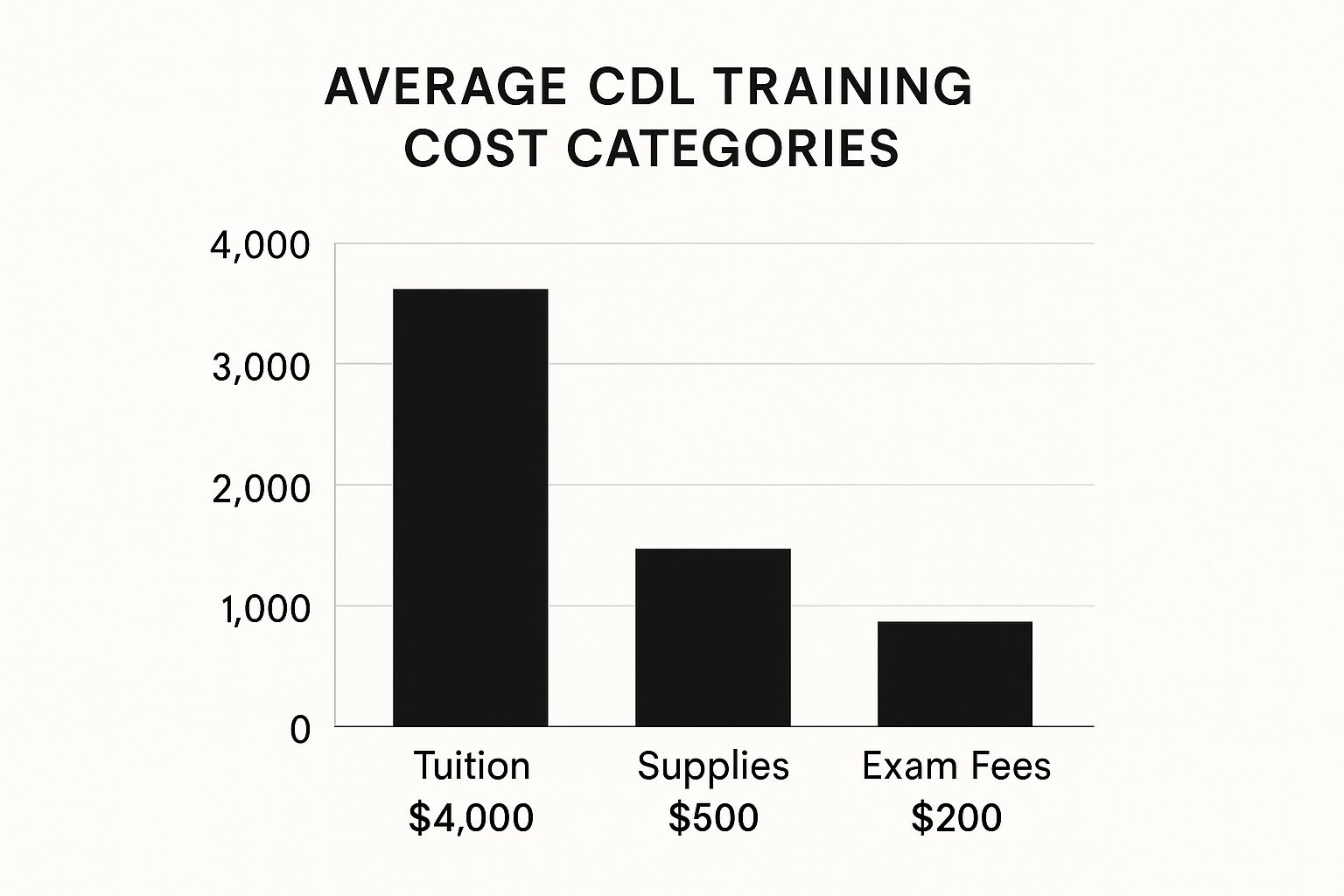
As you can see, tuition is the biggest piece of the pie. That cost covers the intensive, hands-on instruction and access to the vehicles and equipment that are essential for high-quality training.
Common Questions About CDL Training Duration
Even with a general timeline in mind, you probably have a few specific questions about how long it really takes to get your CDL. It’s smart to get these cleared up before you commit to a program.
Let's break down some of the most frequent questions people ask. Getting these details straight helps you set the right expectations and pick a school that actually works for your goals.
Can I Really Get My CDL in 2 Weeks?
You'll see ads for super-fast programs, but let's be realistic. A quality Class A CDL program is going to take three to four weeks at the very minimum, and that’s for an accelerated course.
Programs that promise a CDL in just two weeks often have to cut corners somewhere. This usually means skimping on the critical behind-the-wheel hours that both the feds and future employers want to see. You might pass the test, but you won't be nearly as prepared for the reality of the job.
It's absolutely crucial to check that any school you're looking at meets the Federal Motor Carrier Safety Administration (FMCSA) Entry-Level Driver Training (ELDT) requirements. A good program gives you the practical experience you need to be a safe, confident driver, not just someone who can pass an exam.
Does the Training Time Include Getting the CDL Permit?
Nope. When a school quotes a training duration, they’re almost always talking about the hands-on driving instruction you get after you’ve secured your Commercial Learner's Permit (CLP).
Getting your CLP is step one. You have to study your state’s CDL manual on your own time, pass the written knowledge tests at the DMV, and get your medical card. You must have that permit in hand before you can legally get behind the wheel of a commercial truck with an instructor.
Some schools might offer a classroom portion to help you study for the permit exam, but that time is separate from the core driving program.
How Long Does Part-Time CDL Training Usually Take?
Part-time training is a fantastic option if you need to keep your current job while you learn. Naturally, though, it stretches out the timeline quite a bit.
While a full-time program might take four to eight weeks, a part-time schedule can last anywhere from 10 weeks to six months. You’re still completing the same number of required hours (say, 160 hours), but they’re spread out over evenings and weekends instead of packed into a 40-hour week.
What About Training for an Automatic Transmission?
The industry is shifting, and many new trucks are automatic. Training in an automatic is often a bit easier and gets you on the road faster. If you test in an automatic, you'll get an "E" restriction on your license, meaning you can only drive automatic commercial vehicles.
This is a common path for new drivers. But what if you want to drive a manual down the road? You won't have to start over. You can simply take a specialized E restriction removal course to learn the specific skills needed to shift a manual and get that restriction lifted from your license.
Ready to stop wondering and start driving? At Patriot CDL, we offer accelerated, hands-on training designed to get you on the road and into a rewarding career fast. Our expert instructors and flexible schedules provide the support you need to succeed. Find out more and enroll today at https://patriotcdl.com.
